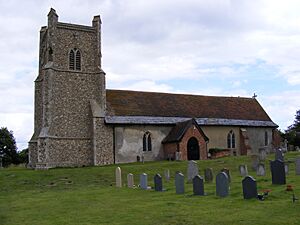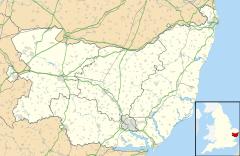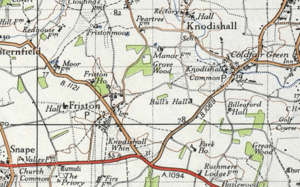Friston facts for kids
Quick facts for kids Friston |
|
|---|---|
 St Mary Magdalene Church, Friston |
|
| Population | 344 (2011 Census) |
| Civil parish |
|
| District |
|
| Shire county | |
| Region | |
| Country | England |
| Sovereign state | United Kingdom |
| Post town | SAXMUNDHAM |
| Postcode district | IP17 |
| EU Parliament | East of England |
| UK Parliament |
|
Friston is a small village in Suffolk, England. It is located in the East Suffolk area. The village is about 3 miles (5 km) southeast of Saxmundham and 4 miles (6.4 km) northwest of Aldeburgh. The River Alde runs along the south side of Friston.
Most of the land around Friston is used for farming. Some lower areas can be a bit marshy. Friston is famous for its old post mill, which was built in the early 1800s. The village is right next to another village called Knodishall. In 2011, about 344 people lived in Friston.
The name Friston comes from an old Anglo-Saxon phrase, Frīsa tūn. This means "the farmstead of the Frisians". Some Frisians might have arrived with the Angles and Saxons long ago. Sometimes, the village is also called Freston.
In 1887, a writer named John Bartholomew described Friston. He noted it as a parish and village in East Suffolk. He said it was 3 miles southeast of Saxmundham. It covered 1846 acres and had a population of 385 people. He also mentioned a place called Friston Hall nearby.
Contents
Friston's Past: A Look at History
Friston has a long and interesting history. Over the years, the village has seen many changes.
Early History and Land Ownership
Friston Hall was once owned by Thomas Bacon. He sold the hall in 1674. This shows how land ownership changed hands over time.
Changes in Local Government
Villages in England are part of different local government areas. Friston has been part of a few different ones:
- From 1894 to 1934, it was in the Plomesgate Rural District.
- In 1934, part of Hazlewood became part of Friston.
- From 1934, it was in the Blyth Rural District.
- Until 1974, it was part of the East Suffolk administrative county.
- From 1974, it was in the Suffolk Coastal district.
- In 2019, it became part of the East Suffolk district.
Friston's Population Over Time
Understanding how many people lived in Friston helps us learn about its past.
Population Numbers in Friston
In 2011, the census showed that Friston had 164 males and 180 females. Earlier records from 1841 show a total population of 455 people. At that time, 210 people were under 20 years old. This means a lot of young people lived in Friston back then.
Population Changes: 1801 to 2011
The number of people living in Friston changed a lot over the years.
- From 1801 to 1850, the population grew.
- After 1850, it dropped to just under 400 people.
- The population then went up and down for a while.
- Around the 1970s, Friston saw a big drop in population. This happened in many rural areas. People often moved to bigger towns or cities for jobs and more activities.
Jobs and Work in Friston's Past
Learning about the jobs people did in Friston helps us understand daily life.
Occupations in 1881
A report from 1881 shows what jobs people had in Friston.
- For men, the most common jobs were in farming and selling goods. About 30 men worked in each of these areas.
- Building houses was also a popular job, with 9 men working in construction.
- Women's jobs were different. About 17 women worked in domestic services, like delivering messages.
- Many women (56) had jobs that were not clearly listed. This might mean they worked mostly at home.
Life in the Friston Community
Friston is a village with a strong sense of community. It is in a rural area, close to the sea, rivers, and woodlands.
Local Attractions and Amenities
- Friston is near a famous bird sanctuary called Minsmere.
- The village has its own windmill, the 'Friston Post Mill', which is from the 19th century.
- There is a church in the village, called St Mary's Church.
- Friston once had nine shops, but its school and post office have closed. However, it is close to nearby towns with shops and supermarkets.
- There are two cinemas and a theatre within four miles of the village.
Village Council and Local Pub
- Friston has a Village Parish Council. It holds an annual meeting with its seven members and a clerk.
- The village has a popular pub called 'Old Chequers Pub'. It has a traditional log burner. In 2014, people worried it might be sold for homes. But it was called a 'community asset', which helped save it.
St Mary's Church: A Historic Building
St Mary's Church in Friston is a very old building. It dates back to the Norman period. The main part of the church was built in the 14th century.
Church Design and Features
The church has a typical design for a parish church. It includes:
- A nave (the main part where people sit).
- A chancel (the area around the altar).
- A west tower.
- A south porch.
Historical Items in the Church
The church holds some interesting historical items:
- A Tudor Bible from 1550. This might be the first Bible ever used in St Mary's Church.
- The churchyard has graves of members of the Bowater family. Three of them were once Lord Mayors of London.
Friston Post Mill: A Tall Landmark
Friston Post Mill is a very important part of the village. It is the tallest of its kind in England.
Building and Ownership of the Mill
- The mill was built in 1812.
- It was said to be built by John Collins.
- Later, it was sold to Joseph Colling of Bramfield.
- In 1813, it was sold again to John Wells of Halesworth for £40.
Repairs and Updates to the Mill
The mill has needed many repairs over the years.
- In 1976, there were 7 major repairs. This was because of a problem with Deathwatch beetles.
- The mill was updated in August 1983.
- It was described as an "outstanding landmark." Even though its sails and fantail were removed, the main machinery that powered three pairs of millstones was still there.
Images for kids







